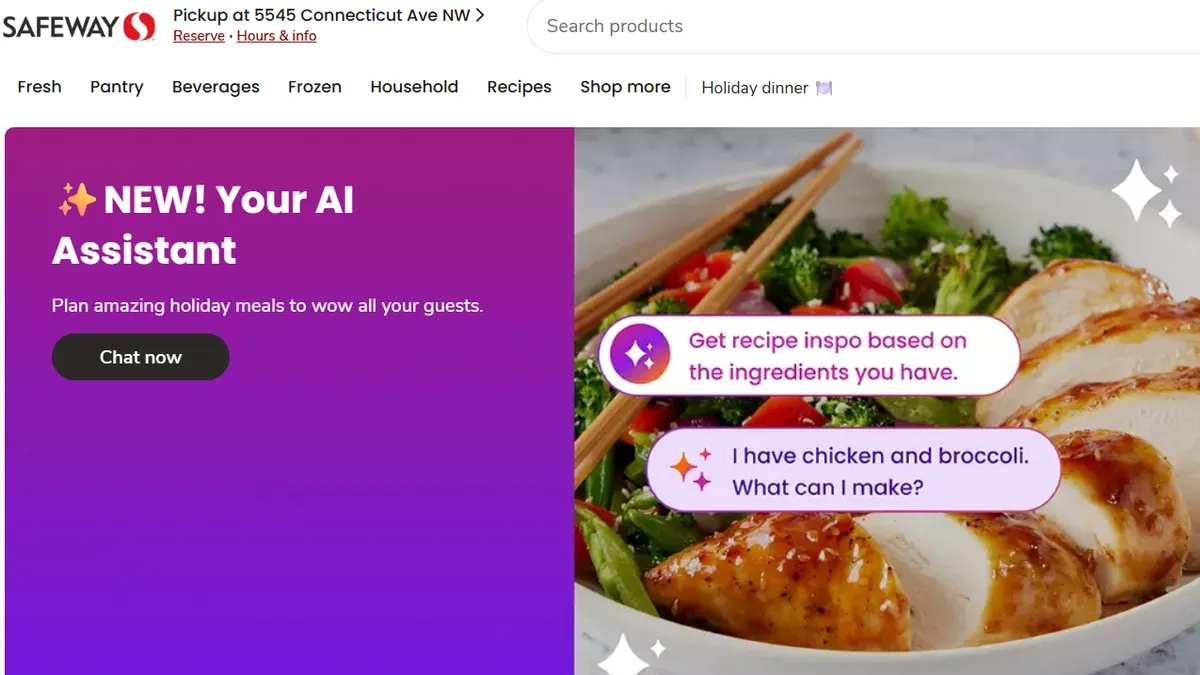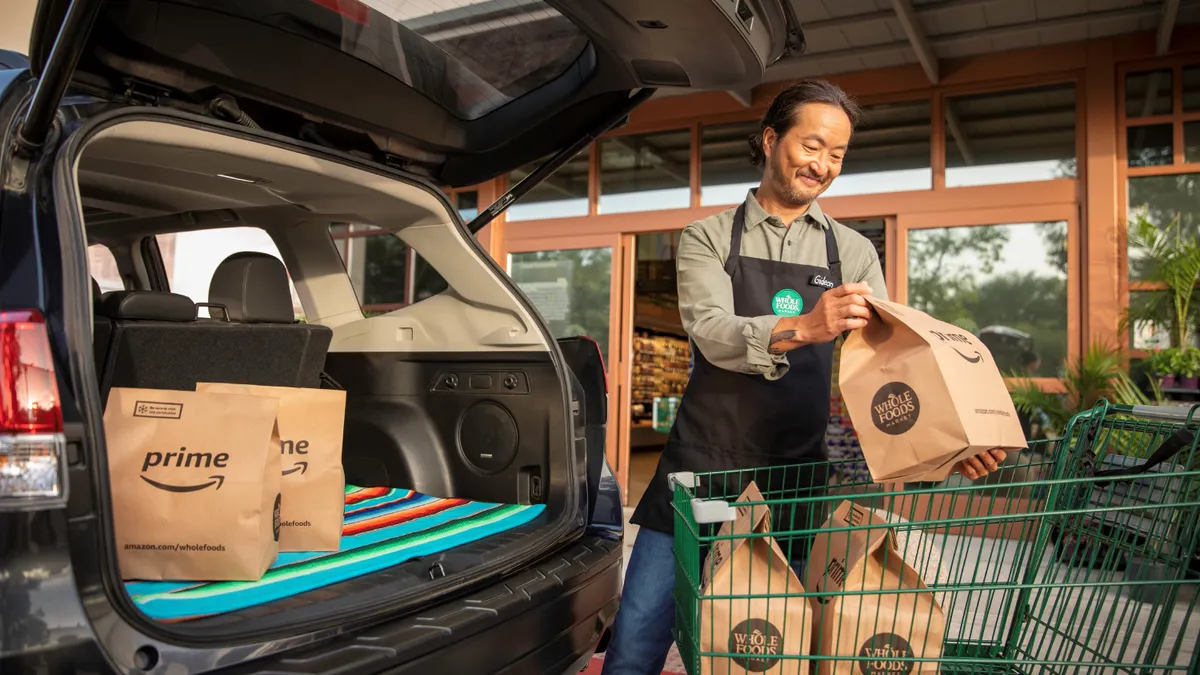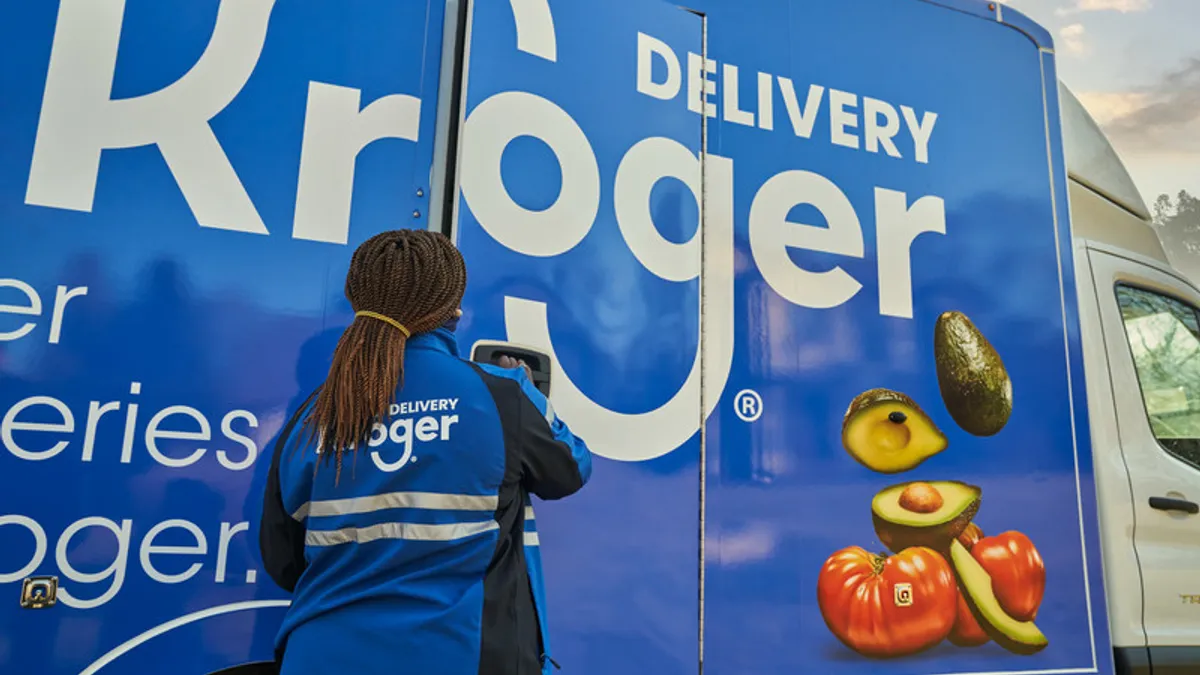As Walmart's grocery business continues to surge, the retail giant is witnessing a change in the way customers perceive its business. The company's online grocery offering has attracted new customers and shown Walmart's ability to innovate from its traditional model, creating a major opportunity to solidify its role as an e-commerce provider.
"[Grocery] has been a great brand halo for us," said Walmart executive vice president and chief financial officer Brett Biggs in a presentation to investors Tuesday at the Bank of America Merrill Lynch 2019 Consumer & Retail Technology Conference in New York.
During the presentation, Biggs emphasized the significant role that grocery will play in the company's e-commerce growth this year, which the company expects to be around 35%. While Walmart currently offers grocery pickup at approximately 2,000 stores, that number will increase to 3,000 stores by the end of this year, Biggs said. Grocery delivery, which is now available at 800 stores, is projected to double.
Grocery was a key driver of the overall business last year, with the company recording record comp sales in the segment driven by an expanded assortment of fresh foods and private labels. In Q4, Walmart reported a 3.3% growth in overall ticket size — a metric Biggs attributes to Walmart's growing mix of business, including grocery, aimed at driving bigger baskets. E-commerce sales grew 43% during the recently reported quarter and 40% during the last fiscal year.
Among its hundreds of millions of shoppers, online grocery customers have proven valuable in boosting overall engagement with stores. It's also bringing in new customers at a time when retailers are fighting tooth and nail for loyalty.
"For us the real sweet spot is getting people to come in store and buy online," said Biggs. "When we do that, we get at least a two-time multiple ... with that customer."
As a result, Walmart is putting more promotional muscle behind e-commerce. During this year's Golden Globe awards, Walmart premiered a commercial featuring cars from iconic films screeching into the parking lot to pick up grocery orders.
The potential for Walmart to succeed at converting online shoppers to in-store shoppers is strong. A 2018 survey from Coresight Research found that the penetration gap between Walmart's in-store and online shoppers was the narrowest of any retailer.
"For us the real sweet spot is getting people to come in store and buy online."

Brett Biggs
Chief Financial Officer, Walmart
Biggs also shared company plans to continue tinkering with the tricky logistics of online grocery, saying that Walmart will be flexible in how these orders are fulfilled. Currently, the retailer uses several third-party delivery partners as well as crowd-sourcing platform Spark Delivery, while store employees pick and pack orders. In the future, Biggs said, Walmart will continue to explore other options, including delivery by its associates. Walmart has used its employees to deliver orders in the past, but nothing has advanced beyond the trial phase.
As evidenced by its rapid deployment of e-commerce, Walmart has been quicker to invest in technology than it used to be, Biggs said.
"When we see things that are working, online grocery would be one of them," he noted. "We roll that out much more quickly than we used to ... and time will tell if we invested the right amount."
Although its breakneck expansion has in the past been a drag on the business — and on the public's perception of it — Walmart is finding its massive brick-and-mortar footprint to be a major strength today in e-commerce. While investors used to question what Walmart would do with its supercenters as retail evolved, Biggs said, now they see it as a major asset in getting online orders to customers' car trunks and doorsteps.
As native e-commerce competitors like Amazon scramble to figure out how to create a physical store base for fulfillment, Walmart is tapping into its 5,000 stores around the U.S. to satisfy fulfillment demands — while also continuing to support in-store shoppers.
"It's validating to me that we already have those assets in place that others are trying to put in place," Biggs said. "E-commerce is challenging. Running a physical footprint is also really challenging, and we're really, really good at this, and we're getting better on the e-commerce side."
Walmart has intentionally slowed the pace of store openings across the country, and Biggs said the company is looking at different ways to use existing supercenters. In addition to allocating more room for grocery pickup and delivery, he said Walmart can devote more space to ancillary offerings such as health care and financial services. Walmart stores also continue to be a community hub in many regions, especially in rural areas.
Biggs noted that health care has changed quite a bit as other retailers have gotten into the business. At Walmart, services such as pharmacy, in-store clinics and diagnostic labs are already in place or being tested, and customers have given Walmart "permission" to be in the space. He anticipates that health care will be a bigger part of Walmart in the future.
"There are things that we can do that can literally change how people live," Biggs said. With Walmart's scale and the support from its customers, Biggs believes that Walmart can make a difference in how people can consume health care.
Throughout the presentation, Biggs expressed confidence and satisfaction with the progress Walmart has made. As for the future, Biggs is optimistic, especially with opportunities in both e-commerce and brick-and-mortar.
"The ability to put those two together in a way that serves the customer ... when you pair that with the mission and culture of our company, and you pair that with our associates and you pair that with our financial strength ... I don't think the formula can be beat," Biggs said.


















